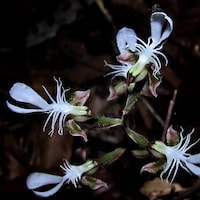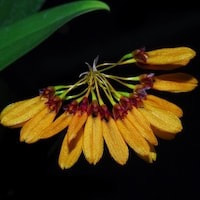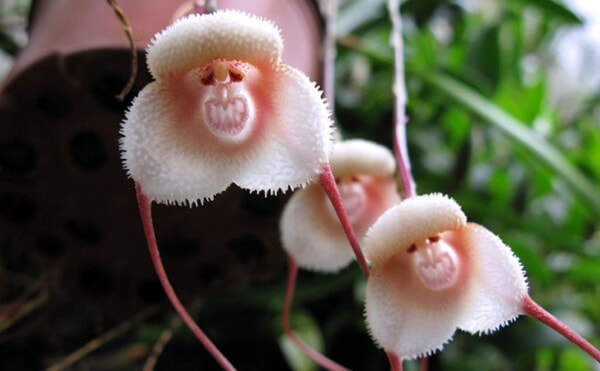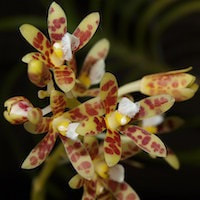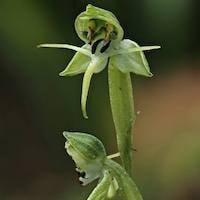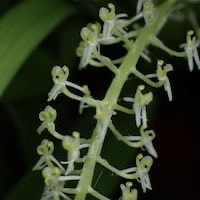WFL9 - Women's Floral 9 - The whiz Orckid
|
Native Singaporean Orchid notes: Neofinetia Falcata
Neofinetia falcata, also known as the Samurai Orchid, is a rare and highly prized orchid used in Floral 9 (Women) for a team-building perfume workshop. First cultivated as a house plant in Japan during the 1600s, it is famous for its beauty and high value, with some sub-varieties selling for up to $100,000. This orchid blooms in June and July, showing its lovely flowers at dawn and dusk. Although native to Singapore, its exotic charm and unique traits make it a sought-after ingredient in fragrances.
|
Therapeutic Orchid notes:
|
Anoectochilus roxburghii (Wall.) Lindl.
Anoectochilus roxburghii, known as Wanna rajah in Sri Lanka and Yaowang (King medicine) in Taiwan, is a striking orchid with dark green to purplish-red leaves and golden veins. Found in humus-rich soils across East Asia and the Himalayan foothills, this orchid is valued for its medicinal properties. It is used in traditional medicine to treat conditions like hepatitis, cancer, hypertension, and tuberculosis. Research has revealed therapeutic compounds in this orchid, including kinsenoside and beta-sitosterol, supporting its role in traditional medicine and highlighting its potential health benefits. |
|
Bulbophyllum retusiusculum
Bulbophyllum retusiusculum, commonly called the Yellow Comb Orchid, is found in regions like Hunan, Taiwan, Hainan, Sichuan, Yunnan in China, and in Myanmar, Thailand, Indochina, Malaysia, Nepal, Sikkim, and Bhutan. In Ubon Rachthani, Thailand, it is known as “Ma tak khok” and is used in traditional medicine to create tonics. This orchid's widespread presence highlights its importance in herbal practices, and its therapeutic properties make it valuable for health benefits in various traditional healing traditions. |
|
Calanthe discolor Lindl.
Calanthe discolor, also known as the Prawn Spine Orchid in China, is recognized for its unique features and medicinal properties. In Chinese, it is called Xiaji Lan or Jiuzilianhuancao. This orchid contains beneficial compounds like calanthoside, glucoindican, and calaphenanthrenol that help improve blood flow and promote hair growth. Traditionally, the whole plant is used to treat conditions such as abscesses, rheumatism, and skin ulcers. Found in Guangdong Province, Calanthe discolor plays a significant role in traditional Chinese medicine for enhancing circulation and healing various ailments. |
|
Dipodium pandanum F.M.Bailey syn. Dipodium pictum (Lindl.) Rchb. f.
Dipodium pandanum, also known as Dipodium pictum, is an orchid species found in lowland rainforests from Papua New Guinea to Southeast Asia. The name "Dipodium" comes from Greek words meaning "two feet," referring to the twin stipes of the orchid. This orchid can grow as an epiphyte, on the ground, or on rocks. In traditional medicine, the leaves are used to make tea for treating respiratory infections in Bougainville, Papua New Guinea. Its natural habitat and medicinal use emphasize its importance in local healing traditions. |
|
Habenaria diphylla (Nimmo) Dalzel Syn. Habenaria humistrata Rolfe ex Downie
Habenaria diphylla, also known as Habenaria humistrata, is an orchid found in damp forests and on rocks in regions from China to India. In Thailand, where it is called Tupmup mot lin, the whole plant is used to treat insect bites. In the Western Ghats of India, the flowers, known as Jeevahi Purusharatna, are used to treat asthma. Its presence and use in traditional medicine highlight its significance in local healing practices and cultural traditions. |
|
Liparis viridiflora (Blume) Lindl.
Liparis viridiflora, also known as the green flower sheep ear orchid in China, is a plant with cylindrical pseudobulbs that blooms from September to December in China and from August to September in the Western Ghats. Found in regions from Sri Lanka and the tropical Himalayas to southern China, Southeast Asia, and the Pacific Islands, this orchid is used in traditional medicine for treating coughs, poisoning, fever, and fractures. Its roots are also used for hernia treatment, showing its importance in local healing practices. |
Other scent note
Spicy note, fruit mix, floral mix, hint of lily, while patchouli, Precious amber, warm woods, Silk tree
Scentopia Library Reference ingredient
Forget me not - Check details at Scentopia's scent library
Download the guided mediation that works best with this Orchid fragrance oil
| women_floral_essential_oil_orchi_00009.mp3 | |
| File Size: | 171870 kb |
| File Type: | mp3 |

